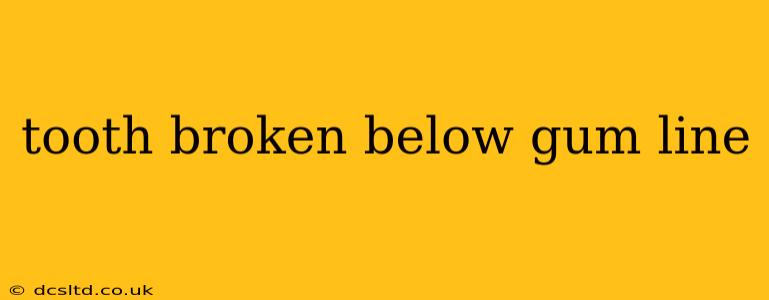A broken tooth below the gum line is a serious dental emergency requiring immediate professional attention. Ignoring it can lead to severe pain, infection, and potentially the loss of the tooth. This comprehensive guide explains what to do if you experience this unfortunate situation, explores potential causes, treatment options, and answers frequently asked questions.
What Causes a Tooth to Break Below the Gum Line?
Several factors can contribute to a tooth breaking below the gum line. Understanding the cause can help prevent future incidents.
- Trauma: This is a common culprit. A significant blow to the mouth, such as from a fall, sports injury, or car accident, can fracture a tooth, often unseen below the gum line.
- Decay: Extensive tooth decay, left untreated, can weaken the tooth structure, making it susceptible to fracturing, even below the gum line. Regular dental checkups are crucial for early detection and prevention.
- Bruxism (Teeth Grinding): Chronic teeth grinding, often done unconsciously during sleep, puts immense pressure on teeth, leading to cracks and fractures.
- Dental Procedures: In rare cases, a tooth might fracture during a dental procedure, although this is usually immediately noticeable.
- Pre-existing Weaknesses: Some teeth may have inherent weaknesses due to developmental issues, making them more prone to breaking.
What Are the Symptoms of a Broken Tooth Below the Gum Line?
Identifying the symptoms early is critical for prompt treatment. Common signs include:
- Severe Pain: This is often the most noticeable symptom, ranging from mild discomfort to excruciating pain, especially when chewing.
- Swelling: Inflammation and swelling around the affected area are common, indicating potential infection.
- Sensitivity to Temperature: Hot or cold foods and drinks might trigger sharp pain.
- Bleeding: While not always present, bleeding from the gum line can be an indication of a fracture.
- Loose Tooth: In some cases, the tooth may feel loose or wobbly.
What Should I Do If I Suspect My Tooth is Broken Below the Gum Line?
Immediate Action is Crucial:
- Contact your dentist immediately. This is not something you can wait out.
- Rinse your mouth gently with warm salt water to help clean the area and reduce inflammation.
- Avoid chewing on the affected side. This will prevent further damage and discomfort.
- Apply a cold compress to the outside of your cheek to reduce swelling.
- Over-the-counter pain relievers like ibuprofen can help manage pain, but do not delay seeking professional care.
How is a Broken Tooth Below the Gum Line Treated?
Treatment options vary depending on the severity of the fracture and the overall health of the tooth. Your dentist will conduct a thorough examination, often including X-rays, to determine the best course of action. Possible treatments include:
- Root Canal: If the nerve is involved, a root canal may be necessary to remove the infected pulp and save the tooth.
- Crown: A dental crown is a cap placed over the remaining tooth structure to protect it and restore its shape and function.
- Extraction: In cases of severe damage or infection, extraction may be unavoidable.
- Dental Implant: If the tooth is extracted, a dental implant can be considered as a long-term replacement.
Can a Broken Tooth Below the Gum Line Heal on Its Own?
No. A broken tooth below the gum line will not heal on its own. Without professional intervention, the fracture can worsen, leading to infection, abscess formation, and ultimately tooth loss.
What Happens If a Broken Tooth Below the Gum Line is Left Untreated?
Leaving a broken tooth untreated can have serious consequences:
- Severe Pain and Infection: The exposed pulp (the soft tissue inside the tooth) is highly susceptible to infection, causing significant pain and swelling.
- Abscess Formation: A painful pus-filled pocket can form at the root of the tooth, potentially spreading the infection.
- Tooth Loss: Ultimately, the tooth may need to be extracted if the damage is too extensive.
- Bone Loss: Severe infection can lead to bone loss around the tooth, further compromising the jawbone's structure.
How Can I Prevent a Tooth From Breaking Below the Gum Line?
Preventive measures are essential to protect your teeth:
- Regular Dental Checkups: At least twice a year for professional cleaning and examinations to detect potential problems early.
- Good Oral Hygiene: Brush and floss thoroughly twice a day to remove plaque and food particles.
- Wear a Mouthguard: If you play contact sports or grind your teeth, wear a custom-fitted mouthguard to protect your teeth from trauma.
- Healthy Diet: A balanced diet rich in nutrients contributes to strong teeth and gums.
- Avoid biting on hard objects.
By addressing a broken tooth below the gum line promptly and taking preventative steps, you can safeguard your oral health and maintain a beautiful, functional smile. Remember, seeking professional dental care is crucial for the best possible outcome.
